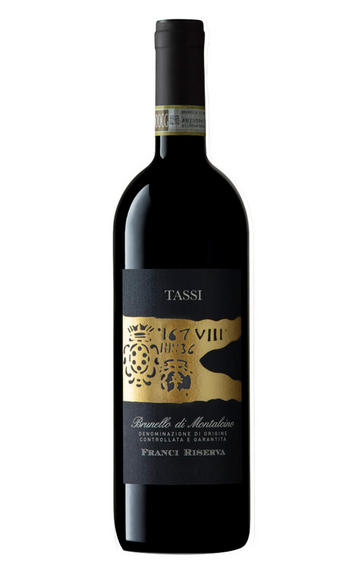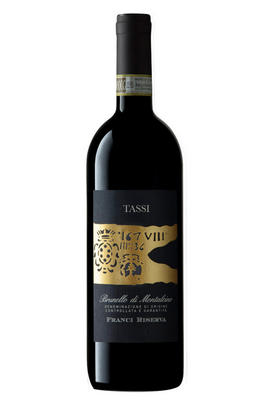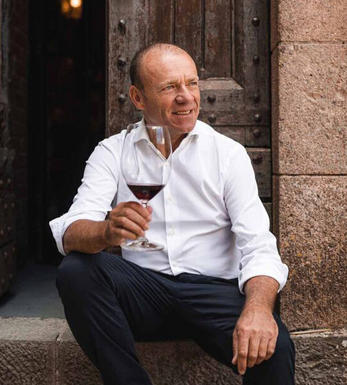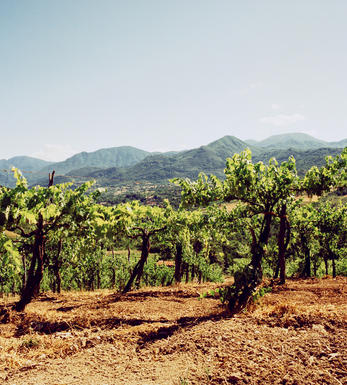
2016 Brunello di Montalcino, Franci, Riserva, Tassi, Tuscany, Italy

Critics reviews
The bouquet on the 2016 Brunello di Montalcino Riserva Franci is deeply rooted in the earth, with notes of underbrush and crushed ashen stone giving way to black currants and savory herbs. It’s far more lifted and delicate in feel than anticipated, presenting a lovely inner sweetness and a pure display of tart woodland berries and hints of sour citrus, all motivated by bright acidity.
The grippy tannins come forward through the finale, combining with a residual coating of primary concentration to create a black hole of structural tension. Keep your hands off of the 2016 for at least a few years, as the best is truly yet to come. The Riserva is produced from the Franci cru, fermented in cone-shaped Garbellotto vats and then aged in 10-hectoliter Slavonian oak for 36 months.
Drink 2024 - 2032
Eric Guido, Vinous.com (December 2021)
Only 3,753 bottles were made.
The Tassi 2016 Brunello di Montalcino Riserva Franci opens to a robust and powerful presentation with thicker layers of dark fruit, blackberry and tarry spice that is enhanced by cedar, mahogany and dustings of exotic clove or cumin. Compared to the 2015 vintage, this expression pulls back to show a linear and focused presentation. The intensity is still quite apparent, but the wine ultimately manages a more elegant and supple delivery, especially on the palate. That said, I really did love the overstated exuberance of the 2015, a more immediate and forthcoming wine compared to this. The 2016 will show its best results further down the road.
Drink 2024 - 2040
Monica Larner, Wine Advocate (February 2022)
The purity of the sangiovese fruit is so beautiful here with cherry, orange peel and cherry blossom, following through to a full body with firm, chewy tannins that are polished and very long. The real deal. One for the cellar.
Try after 2024
James Suckling, JamesSuckling.com (November 2021)
Tassi produces a Riserva from the estate’s oldest plantings. It hails from the Franci vineyard where vines are now over 40 years of age. An east- to southeast-facing parcel, it benefits from the gentle morning sun. The 2016 is well-defined with liquorice, bay laurel, plum and background notes of creosote and leather. Seductively textured tannins fill the mouth, becoming rather firm and resolute in their progression. This is robust and compact yet vibrantly complex. Finishes with traces of helichrysum.
Drink 2024 - 2039
Michaela Morris, Decanter.com (November 2021)
About this WINE

Tassi
The Tassi family have deep roots in Montalcino. They have a legacy of working the vineyards of Biondi Santi and then as beekeepers, before turning their attention back to wine. Owner Fabio Tassi is a restaurateur, running the town’s flagship Drogheria Franci restaurant, and he owns its most prolific wine shop. His exposure to, and understanding of, Brunello’s wines, vintages and vineyards are greater than most – as are his relationships with many of the great winemaking families of Italy.

Brunello di Montalcino
Along with Chianti, Brunello di Montalcino is Tuscany's most famous DOCG and the region's boldest expression of Sangiovese. Located 30 miles south of Siena with the hilltop town of Montalcino as its epicentre, its 2,000 hectares of vines are naturally delimited by the Orcia, Asso and Ombrone valleys. Brunello is the local name for the Sangiovese Grosso clone from which Brunello di Montalcino should be made in purezza (ie 100 percent).
The Brunello di Montalcino DOCG has a whale-like shape: at its head, at 661 metres above sea level on ancient, stony galestro soils facing east and southeast lies the town of Montalcino, where the DOC was founded. As you follow the spine south towards the tail, the vineyards lose altitude – those around Colle Sant'Angelo are at 250 metres – while the soils become richer with iron and clay. Further east, in the shadow of the 1,734 metre Mont'Amiata lies the village of Castelnuovo dell'Abate where the vineyards are strewn with a rich mix of galestro, granitic, volcanic, clay and schist soil types.
Historically, the zone is one of Tuscany's youngest. First praised in 1550 by Leandro Alberti for the quality of its wines, it was Tenuta Il Greppo who bottled the inaugural Brunello di Montalcino in 1888. By 1929, the region had 925 hectares of vines and 1,243 hectares of mixed crops, while in 1932 it was decreed that only those wines made and bottled within the commune could be labelled as Brunello di Montalcino. Since then, the number of producers has risen from 11 in 1960 to 230 in 2006, while over the same period the vineyards have expanded from 1,000 hectares to 12,000. The region earned its DOC in 1966, and was upgraded to DOCG in 1980.
Brunello di Montalcino cannot be released for sale until five years after the harvest, or six years in the case of Brunello di Montalcino Riserva. During this time the wines should be aged for at least two years in oak, followed by at least four months in bottle (six months for Riservas); maximum yields are 55 hl/ha.
Rosso di Montalcino is declassified Brunello di Montalcino, released for sale 18 months after the harvest.
Recommended producers: Costanti, Fuligni, Lisini, San Giuseppe, Soldera, Cerbaiona

Sangiovese
A black grape widely grown in Central Italy and the main component of Chianti and Vino Nobile di Montepulciano as well as being the sole permitted grape for the famed Brunello di Montalcino.
It is a high yielding, late ripening grape that performs best on well-drained calcareous soils on south-facing hillsides. For years it was blighted by poor clonal selection and massive overcropping - however since the 1980s the quality of Sangiovese-based wines has rocketed upwards and they are now some of the most sought after in the world.
It produces wines with pronounced tannins and acidity, though not always with great depth of colour, and its character can vary from farmyard/leather nuances through to essence of red cherries and plums. In the 1960s the advent of Super Tuscans saw bottlings of 100% Sangiovese wines, as well as the introduction of Sangiovese/Cabernet Sauvignon blends, the most famous being Tignanello.


Buying options
Add to wishlist
Description
Planted in 1979, this is a highly desirable spot; the terroir gives detailed, expressive wines. Fabio shares this hillside with Poggio di Sotto and Stella di Campalto. Blood orange, damson, earthy forest fruits and sweet oak spice lift the nose. The palate has a tight core of fruit and smoky mineral grip; time will reveal its true character.
Drink 2026 - 2042
Davy Żyw, Senior Buyer, Berry Bros. & Rudd
wine at a glance
Delivery and quality guarantee